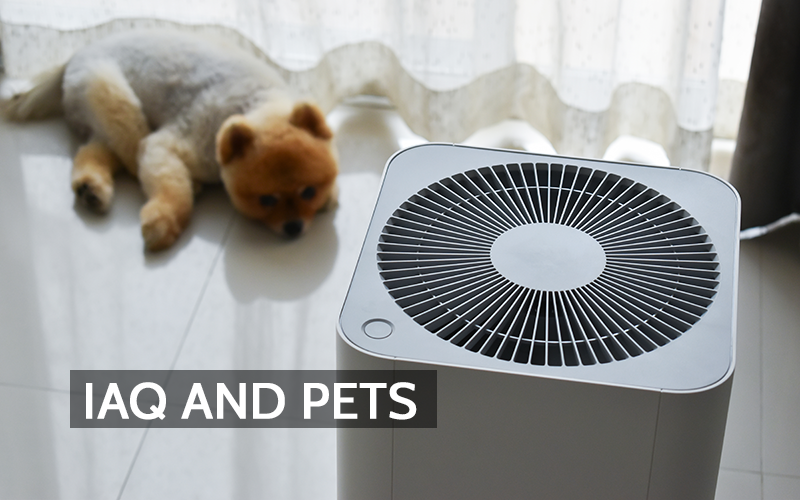Maintaining clean air indoors is essential, not only for people but for pets, who often have even greater sensitivity to household pollutants. Many common household items and activities can harm air quality, exposing pets to respiratory issues, eye irritation, and even long-term health problems. Here’s a look at potential air quality hazards for pets and ways to protect them at home.
Common Household Pollutants Affecting Pets
- Tobacco Smoke and E-cigarette Vapors
Smoking indoors creates lingering airborne toxins that pets inhale. Even secondhand smoke can cause respiratory issues and increase cancer risk in pets. Similarly, e-cigarette vapor contains chemicals harmful to animals, especially small ones with sensitive respiratory systems. - Household Cleaners and Air Fresheners
Many cleaning products and air fresheners emit volatile organic compounds (VOCs) that can irritate pets’ lungs, eyes, and skin. Some compounds may lead to more severe conditions over time, including respiratory diseases. Switching to natural, pet-safe cleaners can reduce these risks. - Scented Candles and Incense
Burning scented candles or incense may fill your home with pleasing aromas, but they also release particulates and VOCs that can harm pets, particularly those with respiratory issues. If possible, avoid using these products or choose unscented, non-toxic options. - Cooking Emissions
Cooking, especially frying, releases particulates and gases into the air. Without proper ventilation, pets may be at risk of breathing in these particles. Using an exhaust fan and limiting high-smoke cooking methods can help protect pets in the kitchen area. - Pesticides and Herbicides
Chemicals used in pesticides, whether sprayed indoors or on lawns, can be hazardous. Pets absorb these toxins not only through inhalation but also through contact with treated surfaces. Keep pets indoors after spraying and explore natural alternatives for pest control. - Dust and Pet Dander
Dust, combined with pet dander, can accumulate in the air, causing allergy symptoms in pets and humans alike. Frequent vacuuming with a HEPA filter and regular dusting can reduce this indoor irritant, creating a more pet-friendly environment.
Symptoms of Poor Indoor Air Quality in Pets
Pets exposed to poor air quality often exhibit signs that mirror human symptoms, such as coughing, sneezing, red or watery eyes, and lethargy. Other indicators may include nasal discharge, increased salivation, loss of appetite, or difficulty breathing. Certain pets, such as those with short muzzles (like Bulldogs or Pugs), elderly animals, and pets with respiratory or cardiac conditions, are particularly vulnerable to poor air quality.
How to Protect Your Pet’s Air Quality at Home
- Invest in Air Purifiers
Air purifiers with HEPA filters can capture particulates and pollutants, improving air quality throughout your home. Consider placing purifiers in rooms where pets spend the most time, and ensure they are cleaned and maintained regularly for optimal performance. - Ventilate Regularly
Good ventilation is key to reducing indoor pollutants. Open windows when possible and use exhaust fans during and after cooking. Proper airflow dilutes indoor pollutants, helping to keep air fresh and breathable for both you and your pets. - Avoid Indoor Smoking and Scented Products
If smoking is necessary, do it outdoors, and avoid burning scented candles or using strong air fresheners. Opt for pet-safe, unscented alternatives when freshening the air to reduce exposure to harmful chemicals. - Regularly Clean and Vacuum
Routine cleaning, especially vacuuming with a HEPA filter, minimizes dust and pet dander. Grooming pets frequently also reduces shedding and dander production, helping maintain better air quality and comfort for everyone in the household. - Use Safe Cleaning Products
Choose natural or pet-friendly cleaning products. Avoid using ammonia, bleach, and harsh chemicals that can release toxins into the air. Switching to homemade or eco-friendly cleaners reduces indoor pollutants and is healthier for your pets. - Limit Exposure to Lawn Chemicals
If you treat your lawn with pesticides or herbicides, keep pets inside for at least 48 hours afterward. Consider pet-safe lawn care products or natural pest deterrents to further reduce chemical exposure. - Monitor Symptoms and Consult a Veterinarian
If you observe any symptoms of respiratory distress or unusual behavior in your pet, consult a veterinarian promptly. Early intervention can prevent minor symptoms from progressing into more serious health issues related to poor air quality.
Improving indoor air quality safeguards the health and happiness of your pets. By minimizing pollutants, using air purifiers, and choosing pet-safe products, you create a safer home environment that promotes their well-being. Prioritizing clean air in the home benefits everyone, ensuring that your pets enjoy a comfortable and healthy space.
Related Article:
Urban Planning Strategies for Tackling Air Pollution
References:
- https://www.trane.com/residential/en/resources/blog/how-pets-impact-indoor-air-quality-and-ways-to-improve-it/
- https://www.nocohumane.org/blog/keeping-pets-safe-during-poor-air-quality/
- https://www.ethosvet.com/blog-post/poor-air-quality-and-pet-safety/
- https://www.everhartvet.com/the-importance-of-air-quality-and-pet-health/


